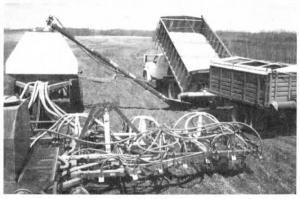1989 - Volume #13, Issue #4, Page #11
[ Sample Stories From This Issue | List of All Stories In This Issue | Print this story
| Read this issue]
Home-Built Air Seeder
 |
"Air seeders are really simple machines. It's hard to justify the money companies charge for them. I built mine for a total cost of $8,500, making a few improvements over existing commercial ma-chines," Don Voss told FARM SHOW.
He bought the fan and feed cup from a nearby manufacturer of air seeders, Eagle Air in Vonda, Sask. He belt drives the fan with an old Rockwell drive axle salvaged from a junked Gleaner C combine. The two back wheels drive the axle, which is operated in high gear, running the fan at between 2,000 and 4,000 rpm's. Because the fan is driven by a differential, the speed doesn't vary on corners like on some commercial units, according to Voss. The top of the tank measures 10 ft., 6 in. from the ground.
The 11-ga. sheet metal that forms the tank was bent and cut at a local steel fabricator. The tank is divided at about a 40:60 split so Voss can seed 95 acres a t80 lbs. of wheat per acre with one fill. The seeder has six 2 1/2-in. primary lines. Each manifold has six 1 1/4-in. outlets.
When used with his 35-shank cultivator, there's one extra hose that Voss uses as a visual monitor, tying it to the second outside shank. It seeds a thick, green row that he later uses to follow when spraying with his 70-ft. wide sprayer.
Voss has used the air seeder the past two seasons. "The first trip over I band fertilizer. The second trip over I seed the crop and blow in a bit of phosphate. The three 18.4 by 26 combine tires used on the seeder have enough flotation so they leave no visible mark in the field.
"One unique feature of my air seeder is the amount of clearance under the tank. There's about 30 in., which is enough to clear a rock if it's pulled up by the cultivator, which runs ahead of the air seeder. Most commercial air seeders can be badly damaged by rocks," says Voss, who seeds at speeds of about 5 mph with a Steiger 270 tractor. "One advantage of using the combine axle to drive the fan is that you can set it in medium or low gear for a faster fan speed in the seeder if you have to travel at slower speeds. Also, the seeder is very easy to pull. We tow it around the yard with a 14-hp. garden tractor."
Contact FARM SHOW Foliowup, Don Voss, Rt. 1, Spiritwood, Sask. S0J 2M0 Canada (ph 306 883-2719).

Click here to download page story appeared in.

Click here to read entire issue
To read the rest of this story, download this issue below or click here to register with your account number.




